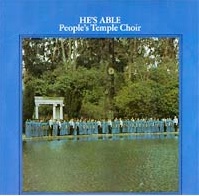 I recently heard He’s Able, the album recorded in the early 1970s by the Peoples Temple choir, an objectively masterful piece of music, and truly beautiful subjectively. I was mainly struck by the opening song “Welcome,” which is performed by kids. It sounds more like a Sesame Street song than a hymn. The best way I can put it is, it’s like a ball of colorful candies held together by mud and clay, colorful and enticing only to those who can’t see through it. I was inspired to transcribe the song and post it on a guitar music sharing site on the net.
I recently heard He’s Able, the album recorded in the early 1970s by the Peoples Temple choir, an objectively masterful piece of music, and truly beautiful subjectively. I was mainly struck by the opening song “Welcome,” which is performed by kids. It sounds more like a Sesame Street song than a hymn. The best way I can put it is, it’s like a ball of colorful candies held together by mud and clay, colorful and enticing only to those who can’t see through it. I was inspired to transcribe the song and post it on a guitar music sharing site on the net.
If you listen to all the songs on the album, the songs these people sang, they’re beautiful. I wish my parents’ Pentecostal church would sing these songs. You really begin to see what inspired the Temple, what people who are motivated are capable of achieving, and what one motivated man is capable of destroying.
* * * * *
I remember the first time I heard about Jim Jones.
I was very young – I’m 17 now – and my older brother and I were watching PBS because there was nothing else on. Some program was playing clips of the Jonestown tapes. I remember being so interested. As a kid who rarely went to church, hearing a religious leader speak in that context was extremely strange. I was probably 5 or 6, but it stuck with me, and in my teens, I started watching newer documentaries about Jonestown, and even older ones as well. It’s a different age now. You can learn about pretty much anything that comes to your mind with the click of a few buttons. You can get an education you can’t get in school, because – it’s true – I wasn’t taught anything about Jonestown in the classroom.
Hearing the tapes now, though, it’s much more chilling, especially the death tape. The crying, the way it gets quieter throughout. It’s dark stuff that I didn’t register when I was young.
I’ve always had an interest in the human psyche, the whole cognitive process, the things you can’t scientifically measure. I guess that explains my morbid curiosity, the need to see just what humans are capable of. But I find that road of “what” leads most people down to “why”: why do some of us commit atrocious acts, while others sit back (an atrocious act on its own) and while others allow themselves to be victims? The answer to the “why” is troubling. You either don’t like the answer or you don’t accept the answer. I’m in the middle.
The “what” is easier to summarise than the “why.” The “what” is that humans can go about as far as their imagination can when it comes to cruelty. The “why” is this:
It is our nature. Even though we would like to think that we would never – could never – hurt someone, we are merely vulnerable and ductile subjects of circumstance. And circumstance affects our behavior and perception more than ourselves. Each and every human being is capable of victimising, and being the victim to, anyone, and for any motive at all. If you’d like to learn more on that philosophy, listen to Alan Watts’ Good vs. Evil is a Stupid Dichotomy.
In Jonestown, in Peoples Temple – as in the rest of life – there’s good and bad only in hindsight. Other than that, there’s just the reality we live in.
(Ethan Sells is a 17-year-old high school student who lives in southwestern Ohio. He listens to Ween and classical music.)